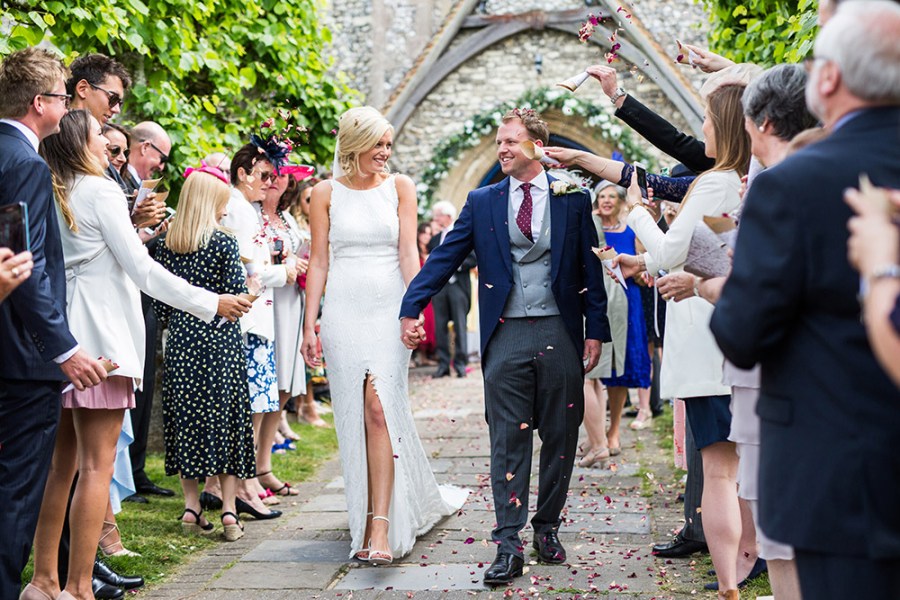Photo opportunities at weddings are endless, but there are certain images that couples will always expect to get. Michael Topham reveals the shots that can’t be missed
Being asked to photograph the most important day in someone’s life is a huge compliment to your knowledge and skill as a photographer, but one that also comes with big responsibility. It’s precisely this that puts off many photographers from contemplating photographing weddings, however if you approach it the right way, capture the key shots and go into it with a fairly relaxed mindset, they’re actually very rewarding and great fun to shoot.
If you’ve ever spoken to a wedding photographer, they’ll probably tell you that no two weddings are the same, which is absolutely true. What appeals to one couple might not to another and people love putting their own stamp on the day to personalise it to how they want it to be. One thing you can be pretty certain of is that the rough agenda of the day will be similar from one wedding to another.
After your first few weddings you’ll quickly get the gist of what’s going to happen next so you can position yourself in the right place at the right time. The key to photographing a wedding successfully is in the planning and communication. A meeting with the couple over a coffee to go through the timings, the group shots they’d like and any other special arrangements is a must, so that you know what’s happening when as well as their expectations.
Striking up a good relationship early, which can also be achieved by arranging a pre-wedding shoot, will help make your couple feel more at ease and rest any nerves they might have of being photographed. When the wedding day finally arrives, try not to overthink it. Let the day unfold naturally and capture things as and when they happen rather than forcing them to happen. This will always result in your images having a very relaxed and genuine feel to them.
If you’re just starting out as a wedding photographer, or you have been asked to assist on the day as second shooter, or have agreed to take a few shots at a wedding for family or friends you’re in the right place. This guide offers the advice and tips you need to getting the must-have shots, along with some kit insights to ensure you get the most from this most memorable of days.
10 photographs to get at weddings
1. Hair and makeup
For wedding photographers, the day often starts by visiting the bride-to-be – so check the best time to arrive. All photographers work differently, but for many it can take half an hour or so to get into the flow. During this time you’ll be getting to grips with your camera settings and starting to build a rapport with the subject so they feel relaxed, which leads to more natural shots.

Hair and makeup artists (MUA’s) like to work close to a window for natural light. Don’t get fixated with shooting from one position for too long and be sure to move around. Don’t disrupt hair and makeup artists from working for long either as this can lead to delays and a mad last-minute rush.
A fast prime lens with an effective focal length of 85-105mm works well for detailed shots of hair being sprayed, eyelashes being curled and decorative hair vines being attached. Don’t be afraid to pull up a chair or stepladder to shoot from a higher position. This can work well with brides who have long hair.
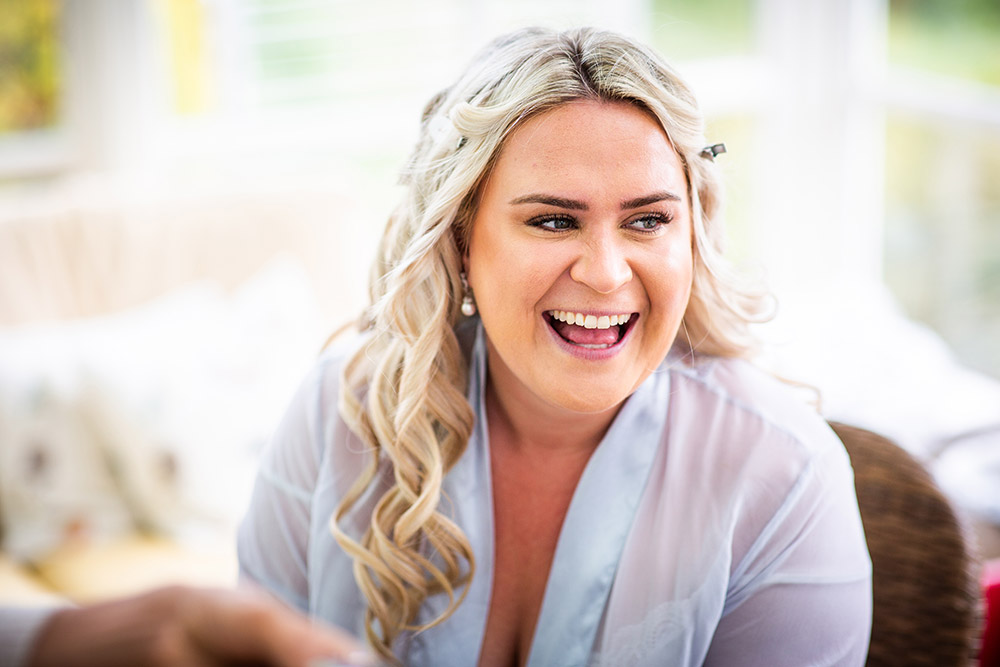
You’ll want to capture the fun, laughter and joyous mood of all those in the room. Suggesting a shot of the bridal party kneeling in their robes on the bed, or asking the bridesmaids to tell an entertaining story about the bride often gets a good reaction. It’s important to give the bride some privacy at the right time, too.
2. The dress
All brides will look back fondly at pictures of their dress. With so much time and money spent choosing the perfect gown, it’s crucial you capture a striking set of images of it. The best time to get shots of the dress before it’s worn is during hair and makeup. Ask the bride politely if she’s happy for a bridesmaid or family member to arrange the dress so it’s hung up out of its garment bag.
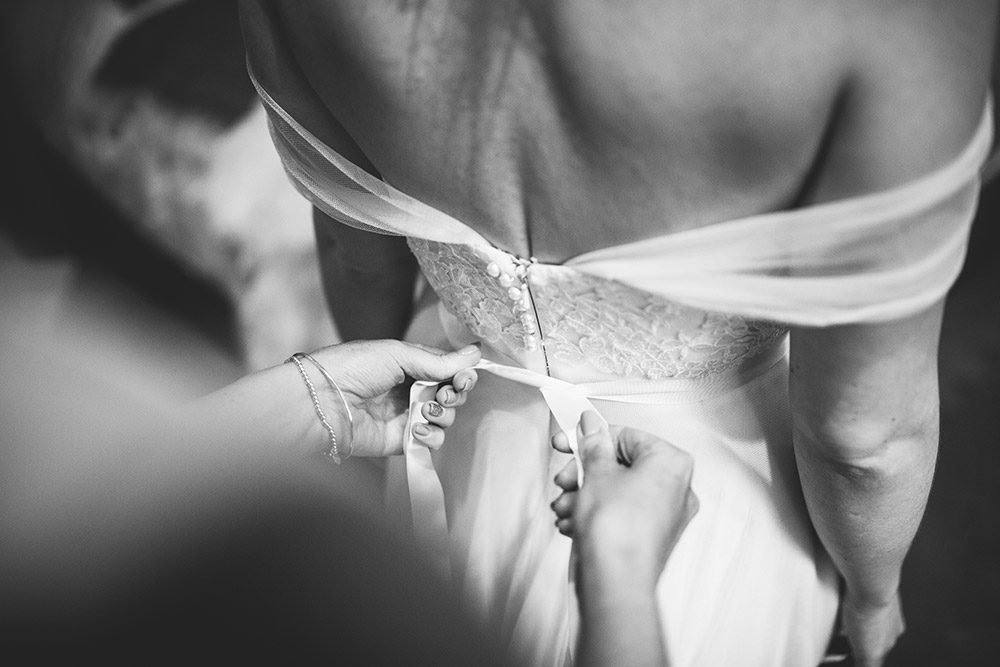
This will allow you to grab a few full-length shots. You might also fancy positioning the bride’s shoes beneath or off to one side. If the dress has some intricate beadwork or lace detail it’s worth capturing some close-up shots at the same time. When the bride is ready to put her dress on, step outside the room for a minute and ask a bridesmaid to call you back in just before it’s done up so you can capture a few more frames.

Another key moment you won’t want to miss is the reaction of the bride’s parents the first time they get a glimpse of their daughter in her wedding dress. I like to stand just behind the bride at this point and typically use my 70-200mm. This will allow you to record the emotion as they enter the room at the long end of the zoom and also the hug that usually follows by pulling back and shooting at the widest point in the zoom range.
Top Tip: If you have a few minutes spare after the bride has got into her dress, don’t be afraid to ask her to hold her bouquet in both hands and stand close to a window so you can capture a few elegant shots of her last moments in natural light before she gets married.
3. Groom preparations
One of the questions you’ll want to ask at the meeting you have with an engaged couple before their wedding is; would you like some photos of the groom getting ready? If the answer is yes then you may need to think about hiring an assistant (known as a second shooter) who can do this for you while you focus on the bridal preparations.
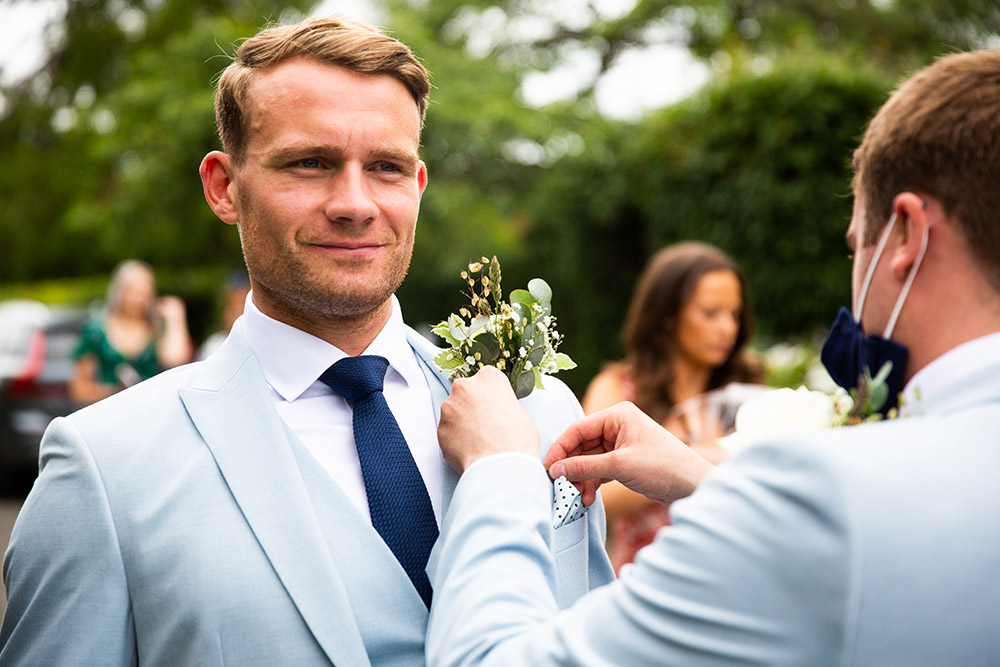
If the groom is due to get ready at the same venue as the bride, or within short walking distance, you might prefer to shoot both yourself and work alone. Doing this does introduce the risk of missing some key shots however as it’s impossible to be in two places at any one time. When you’re photographing the groom preparing, strike up a conversation between shots so he becomes comfortable with you working around him.
Look for details to photograph too, such as polished shoes and the rings, which the best man should be keeping safe. Some grooms like to go for a swift half at a nearby pub to settle any nerves they may have before the ceremony. This is a good time to capture a few relaxed shots of the groom and groomsmen and saves time having to do it later.
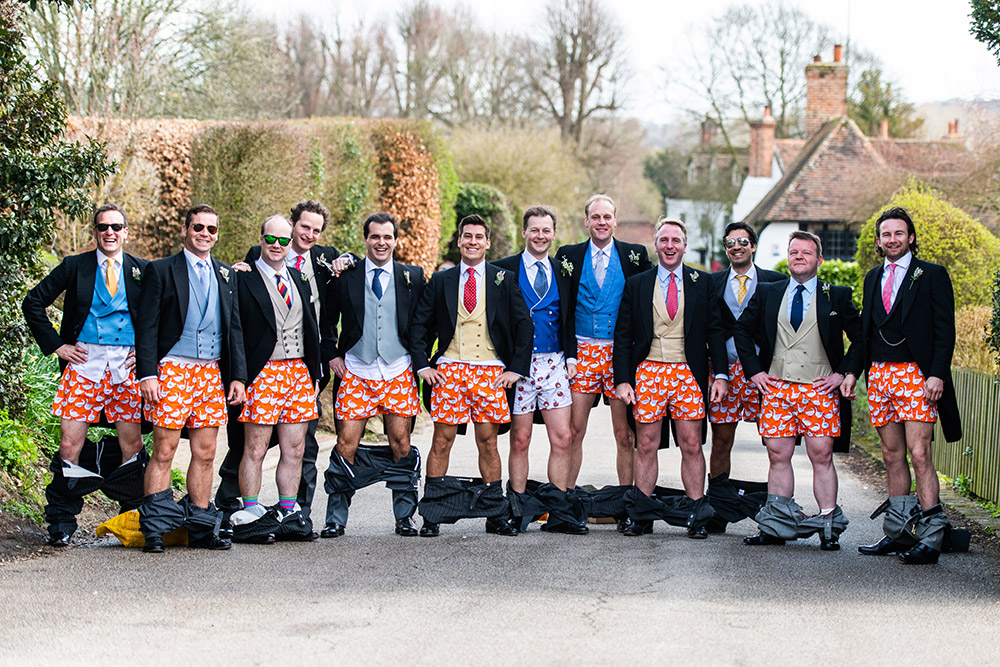
One of my personal favourite shots to get of the groom is the walk to the venue with groomsmen in tow. To give yourself the best chance of getting this shot you’ll want to be quite a way ahead of the group and set your camera to its burst mode with continuous autofocus deployed. Sometimes you might even get an odd request.
I’ll never forget the time I got asked to photograph all the groomsmen with their trousers around their ankles in the street so the married couple had a photo of them all wearing matching underwear. You have to be ready for anything at a wedding!
4. The exit shot
Rather like the first kiss, the exit shot of the couple leaving the church or place they’ve got married at can be challenging as you only have a few seconds to nail it. Nobody wants to hire a photographer who constantly asks for key moments to be repeated because they were unable to get the shot first time. A great exit shot requires some organising on your part.
Ask the couple kindly to wait off to one side or around the corner for a few minutes while you gather family and guests together to create an avenue for them to walk through. If you don’t feel comfortable raising your voice to move people into position, kindly ask the best man or ushers to help. If confetti is on the agenda make sure everyone has a good handful and let the guests know to throw it as high as possible.
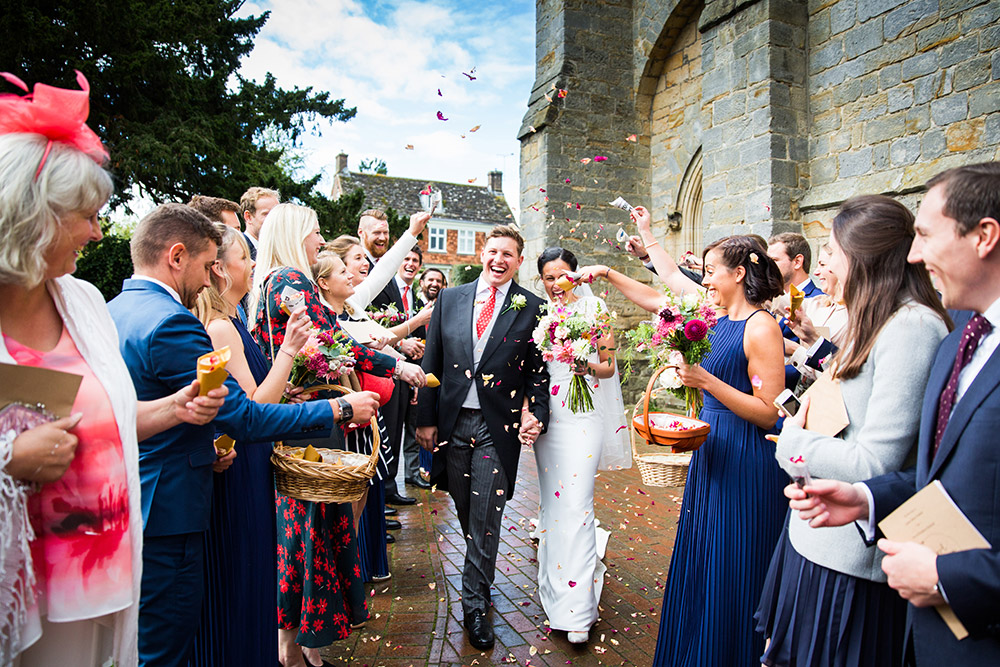
The slower the couple walk down the avenue, the better the chance you’ll have of getting some striking shots – and don’t forget to tell the couple this before giving them the big thumbs up to start walking towards you. As you backtrack be mindful of people’s feet and any obstacles that could trip you up. Keep shooting until you reach the end of the avenue.
Asking the couple to briefly pause at the end and look back at all their guests while raising their hands makes for another good shot. There’s no right or wrong lens to use for the exit shot, however I typically find myself using my 24-70mm standard lens so I can control the angle of view instantly with a short sharp twist of the zoom ring.
Top Tip: To freeze confetti mid-air and minimise any risk of handshake I’d always recommend shooting exit shots with a shutter speed no slower than 1/500sec.
5. Venue
If you’ve carried out your planning and research correctly you should have a good idea of the best places to shoot at the venue before you arrive. If you do find yourself stuck for inspiration, try searching the venue on Instagram to get some more ideas of how other wedding photographers have approached it.

Wedding couples spend a huge amount of time and effort on the lead up to their wedding arranging the small details to put their own stamp on the day. It’s these little details that you’ll want to allocate time to photographing. Shooting a few wider shots of the rooms and the overall setup can show the venue off at its best.
The kind of details your loving couple will want to look back at and reminisce in the future include things such as the signage, the wedding arch, the layout of the room, place settings, the arrangement of flowers and maybe the memorial table or candle (if there is one). After you’ve walked around and captured these details it’s worth thinking about stepping outside.
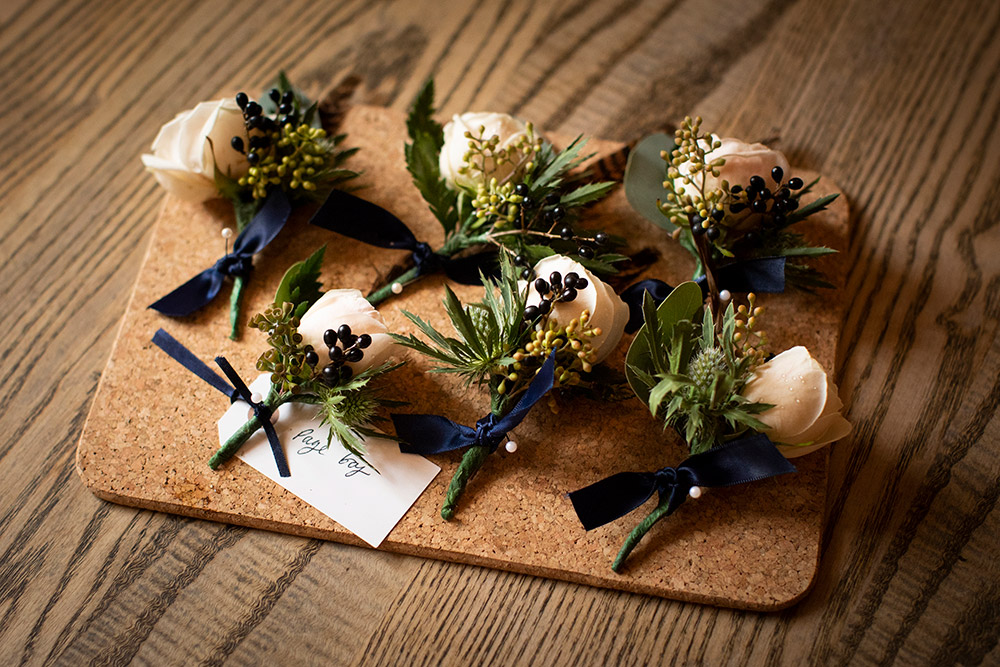
Scenic shots of the grounds, gardens and any other points of interest such as signs or wildlife are a great way of breaking up people pictures in an album or online gallery. As you walk around getting your venue shots, look out for interesting backdrops, paths, walls, staircases and any other feature that might work well for the couple and group shots later in the day.
6. First kiss
This can be one of the trickiest shots to get and easily missed if you’re not on the ball. The trick is is to be ready in the best possible position. Many vicars, registrars and celebrants will be happy for you to shoot fairly close to the couple during the service if you promise not to be invasive or off-putting.
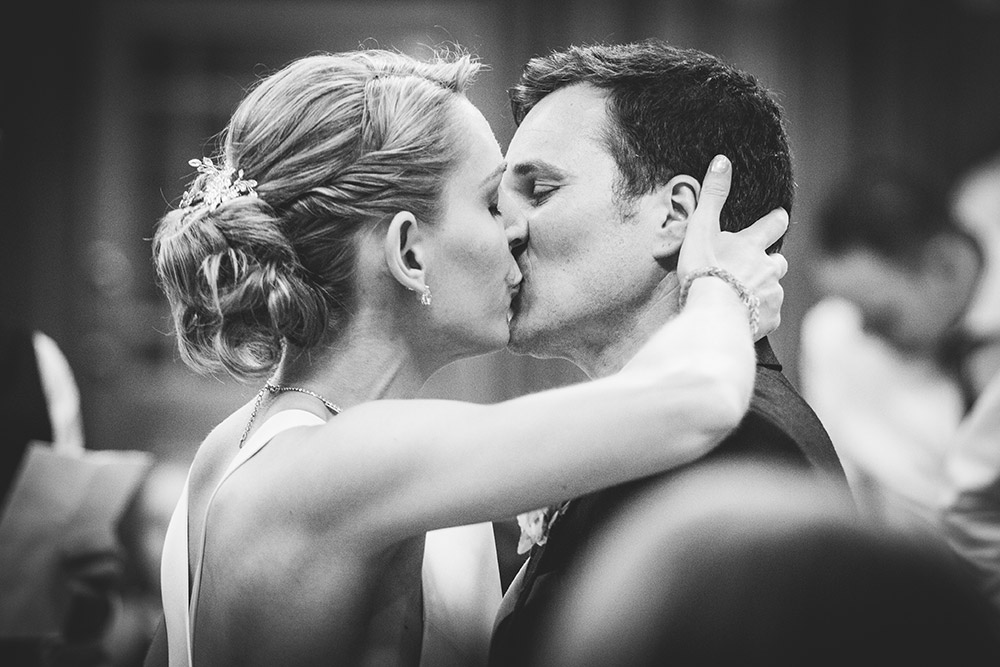
Some will ask you to set your camera to its silent mode – get into the habit of doing this as soon as you walk through the doors. I usually find myself crouching down in between the first row of pews to grab a few frames as the bride walks down the aisle. Straight after this I take a quick shot of the groom’s reaction before finding a spot that gives a clear view of the couple and their guests behind as they exchange their vows.
The classic wedding phrase ‘you may now kiss the bride’ isn’t always said, so as the formalities draw to an end you’ll want your camera raised to your eye ready to shoot as soon as the first kiss happens. Having your camera in its burst mode is a must to give yourself the best chance of capturing the shot.

Don’t be tempted to review your shots on the spot. This can wait as you’ll want to also capture the natural smiles and happy emotion as the couple pull away from their kiss. How wide you shoot is entirely up to you, however shots where the couple are larger in the frame tend to have the most impact.
7. Couple pictures
At some point after the ceremony, you’ll want to factor in time to capture a series of shots of the married couple together. When I first started out shooting weddings I created a scrapbook of all the shots and poses I wanted to try with my wedding couples, which quickly became engrained in my memory.
Over the years I’ve taken a more relaxed approach to couple pictures and like to keep them as fun and as unstaged as possible. Let the married couple chat, laugh, kiss and be themselves as you take a slow-paced walk through the gardens or grounds of the venue, stopping off at the locations you spotted earlier.
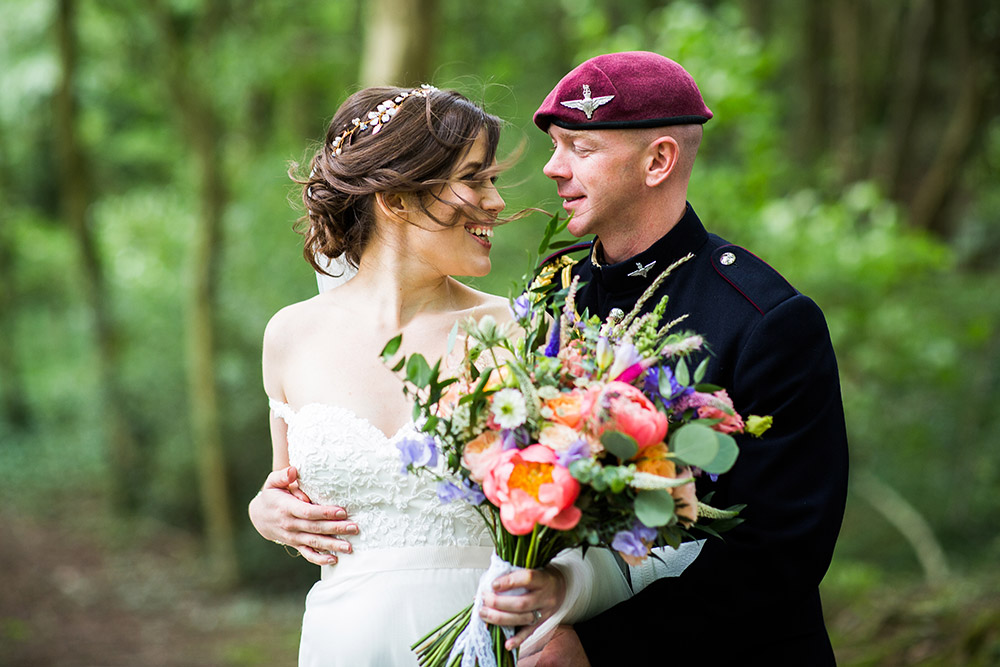
Try some shots of the happy couple walking towards you, standing still holding hands and embracing closely. Don’t be afraid to offer direction on where you’d like them to stand or look. You won’t be working with professional models who know how to strike a new pose as soon as the shutter has been triggered so your guidance and positive encouragement will go a long way to getting the results you’re after.
If the couple ask to see a few shots show them, but don’t offer to do this as it wastes vital time. After 30 minutes or so your couple will be itching to get back to their guests and canapés. You’ll want to shoot as many shots as you can in this time, but don’t fret if you think you’ve missed a few opportunities.
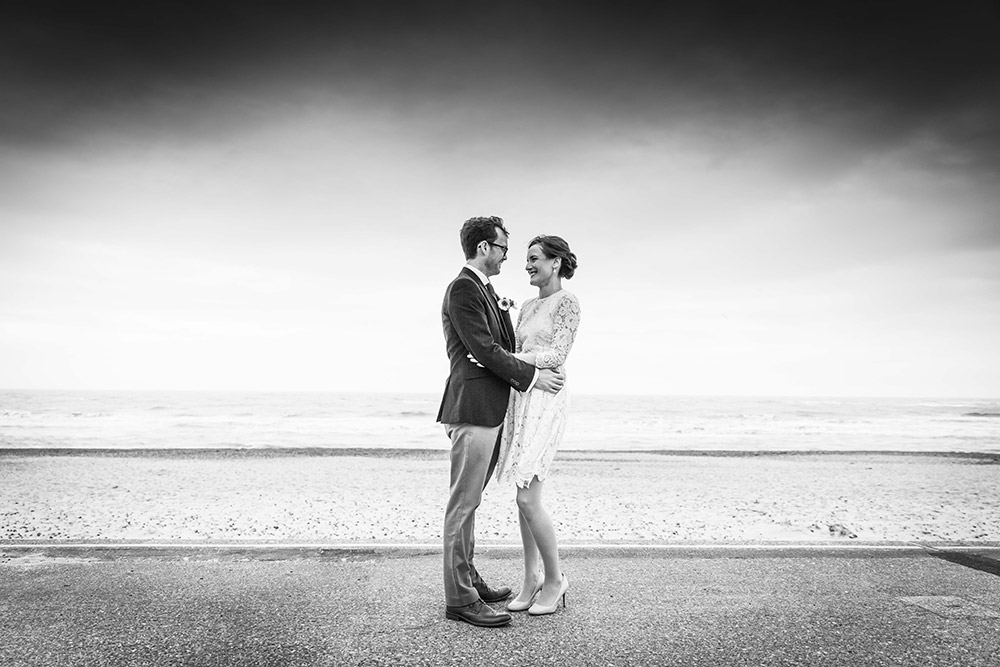
Explain there are a couple more you’d like to take later in between food courses or when the light is at its optimum. Most couples will happily oblige if it means getting a once-in-a-lifetime shot of them.
Top Tip: If you’re photographing on a bright sunny day take your couple into the shade to avoid squinting and any harsh shadows. It’s worth capturing a few frames shooting towards the light too – just remember to set your metering mode to spot metering and tweak exposure compensation if needed.
8. Group shots
Group shots are some of the most important shots you’ll take on the wedding day. They’re not the most exciting to shoot, but you can guarantee that your couple will look back at them fondly and print a few to pop in a frame to create gifts for various family members. First things first, you’ll want to have a list to work to.
A few weeks before the wedding you’ll need your couple to write down exactly which group shots they want, including the names of the people. Try to aim for no more than ten group shots, on the basis it takes time to locate everyone and you don’t want to be that photographer who ruins the couple’s day by making the process tedious.

For a really slick operation I like to get the best man on side to find the people who are needed for the next shot. As soon as I’m done with one group of people, I can bring in the next and so on. Try to work to getting your group shots done and dusted in 30 minutes. Sometimes this isn’t possible and the process will overrun, but try to be as efficient as you can be.
Remember the best group shots are the fun ones, so make sure you encourage people to put their arms around each other, get close, laugh and have fun. Don’t worry if the couple or guests look off-camera either as this can give shots a much more natural look to them. For the group shots of four to ten people don’t be afraid to frame up tightly so that the image cuts off at knee height.
Shoes aren’t important in group shots. When you attempt the big group shot with everyone, elevation is key to success. Getting up high and shooting down will allow you to see everyone’s faces. Ask the venue where the best place is to shoot from and they’ll point you in the right direction. Some might even have a ladder ready and waiting for you.
Top Tip: A fast prime with an effective focal length around 50mm is ideal for capturing small group shots. Just remember when you shoot the big group shot, you’ll want to use an aperture around f/5.6 to f/8 to uphold excellent sharpness across the frame. This is likely to be narrower than the aperture you will have used for previous shots.
9. Speeches
The speeches are often a real highlight of a wedding. It’s the time when you get to find out all about the couple you’re photographing and capture people in hysterics from all the funny stories and jokes that are told. They can happen at any time during the day, but more often than not they’re either before or after the meal.
Some people choose to split them up between food courses too. Check the time and location of the speeches and refer to them from the agenda. You’ll want to request this before the wedding and have access too on the day so you know if things are running to time or behind schedule.
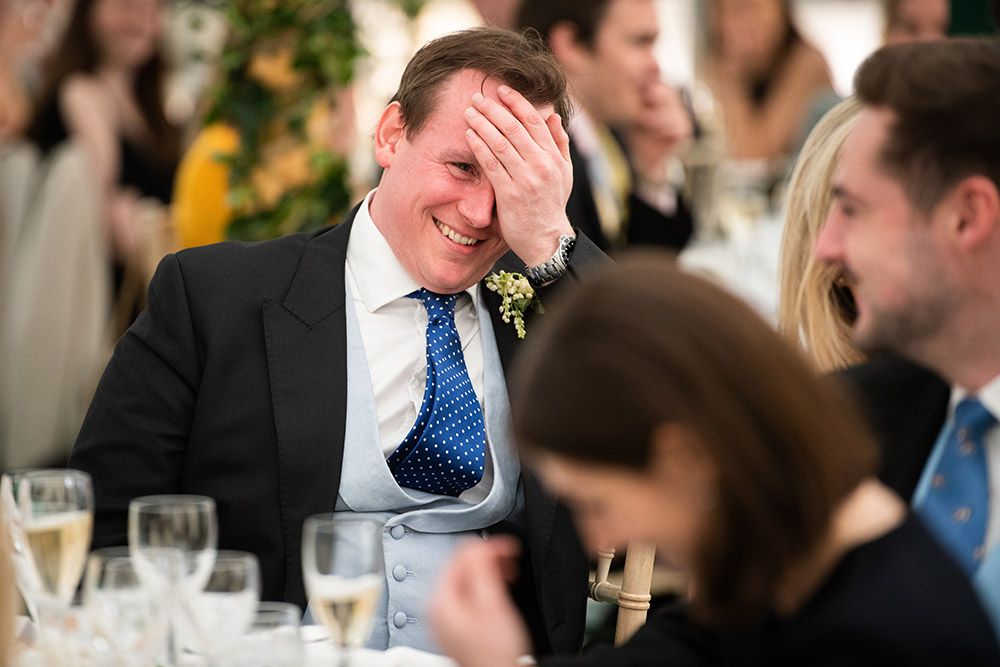
As important as it is to get a few shots of the key speakers saying a few words, what you really want to focus on are the reactions and emotions. If you have the luxury of a second shooter working beside you, decide who is going to capture the couple’s reaction to what’s said and who is going to photograph the guests.
You’ll want a fast shutter speed upward of 1/250sec and rather than waiting for a moment to happen only to find you responded too slowly, have the viewfinder raised to your eye scanning between people ready to fire at the opportune moment. Much like the preparation shots earlier in the day, don’t get fixated on shooting from the same position. Move about, try shooting from high or low angles and make sure you take plenty.
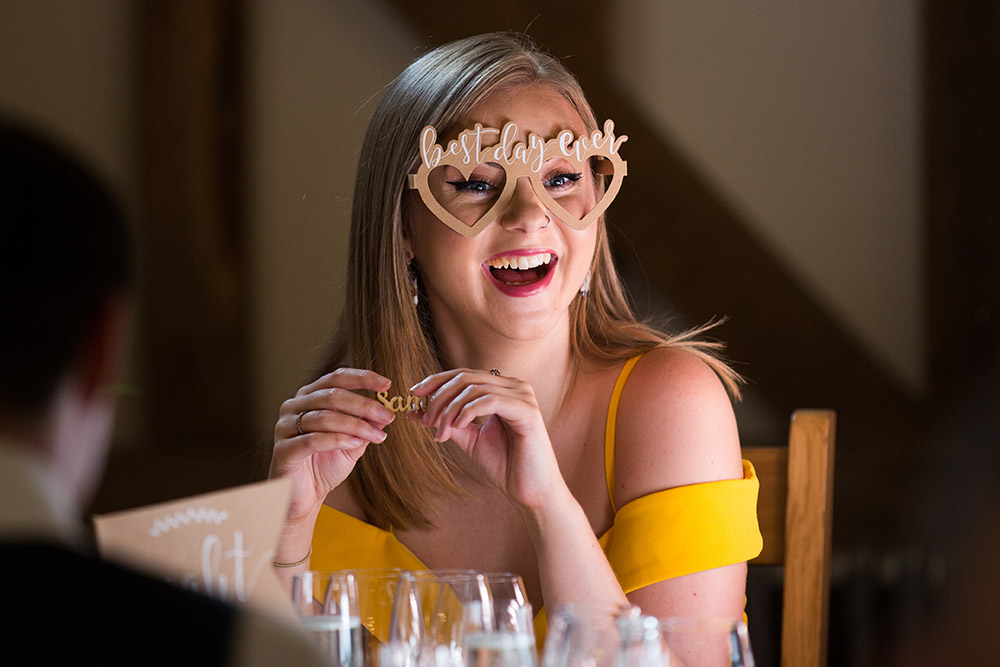
Top Tip: A long lens such as a 70-200mm is ideal for zooming in closely from the edge of the room. To emphasise the person you’re photographing and avoid distracting backgrounds, shoot with a wide aperture around f/2.8 to f/4.
10. Dancefloor antics
It’s a well-known fact that a good party at a wedding starts on the dancefloor. It also tends to be where most couples embark on their first dance together as a married couple. This can be a challenging moment to photograph, particularly if you’re working in dark conditions that aren’t conducive to using fast shutter speeds without pushing the ISO uncomfortably high. You’ll likely want to turn to your flashgun or flashguns to help freeze fast movements and illuminate the scene.
Try positioning yourself the opposite side to all the guests watching the first dance so you can use them as your backdrop and make the image feel busy. If you’re lucky the DJ’s colourful lighting set-up might be all you need to get a spectacular first dance shot, but don’t bank on it. Gaining some height on a stepladder and shooting down is worth a try too.

The ten to 20 minutes after the first dance is a great time to capture guests letting loose as they flock to the dancefloor. Don’t be afraid to get stuck in amongst the crowd. Some of the best dancefloor shots are those taken on a wideangle lens slap bang in the middle of it all. To give your dancefloor images a sense of speed and movement you’ll want to learn how to use slow sync flash. This can result in extremely vibrant and fun-looking shots that are more pleasing on the eye than the frozen effect you get with standard flash.
You’ll want to make an effort to go around shooting different groups of people on the dancefloor too. Tapping guests on the shoulder and suggesting they gather together for a quick shot usually works well and before you know it other people will cotton on and ask you to photograph them.
Top Tip: Photographing a wedding is an extremely long day, but you shouldn’t plan to rush off home straight away after the first dance. Persuade the couple to get you a drink and in return stay for a little longer to capture some more entertaining shots. Always make a point of saying farewell to the couple too before you leave and inform them of when they can expect their images.
Kit list for weddings
Cameras

Camera failure is everyone’s nightmare. It’s this reason you’ll see all wedding photographers carry a minimum of two cameras so they have a spare to turn to should one fail when it’s least expected. Have a look at our recommendations for the best cameras for wedding photography!
Batteries
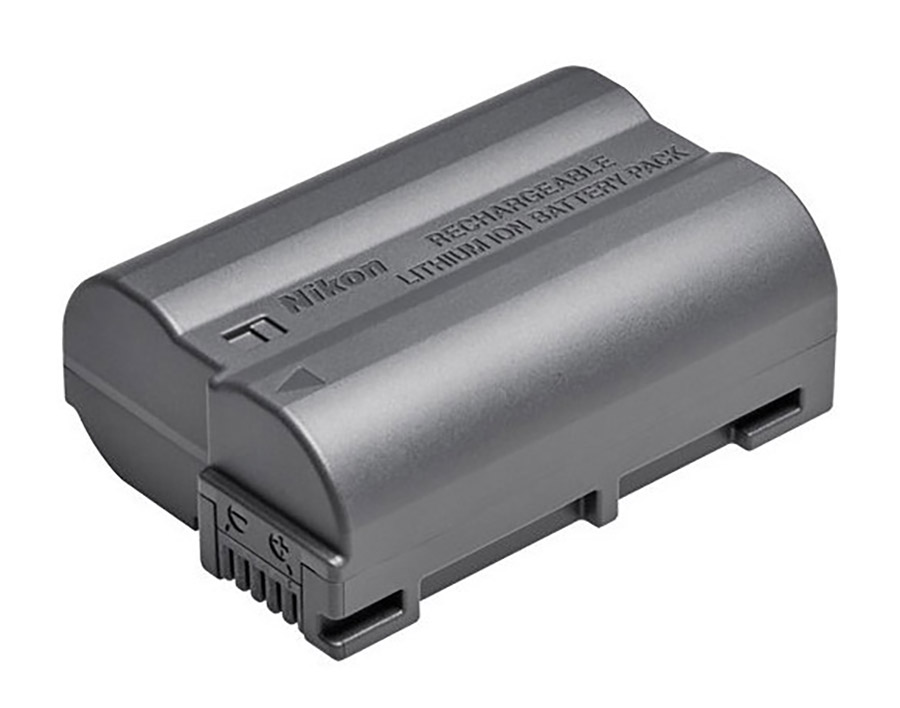
A good supply of spare fully-charged batteries is essential as your camera will be powered all day, ready to shoot any spur-of-the-moment opportunities. Don’t leave all your spares in your bag. Keep one on you for instant access at all times.
Memory cards
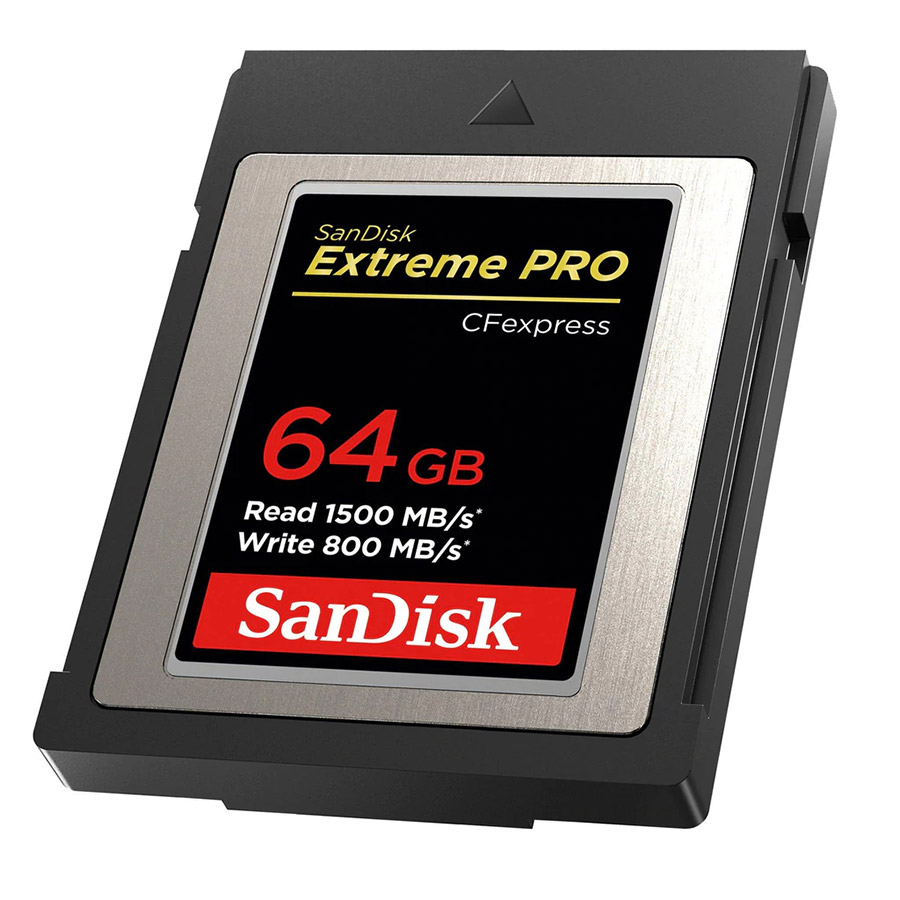
If your camera has twin card slots, set up the camera so it duplicates images to both cards simultaneously. This will give you a backup should a card unexpectedly corrupt. Use fresh cards at regular intervals too, just to be on the safe side.
Flashgun

You can’t guarantee that you’ll be blessed with bright lighting conditions at weddings. A flashgun is essential for adding some extra illumination indoors and will allow you to get creative with slow-sync flash on the dancefloor.
Roller bag
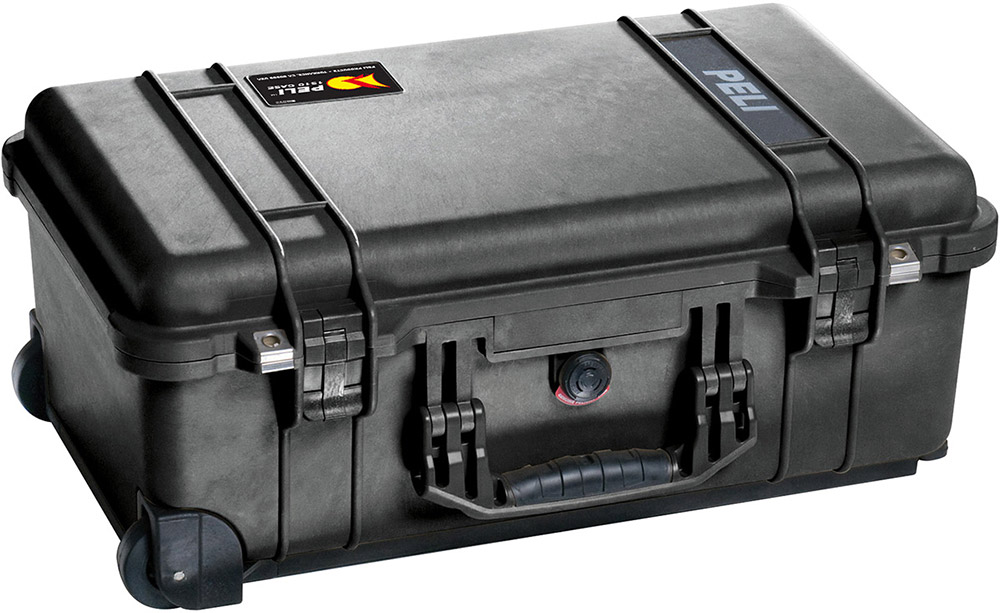
A rolling camera bag or Peli case will offer good protection while letting you drag your kit to where you need it. Your shoulders and back will thank you for it. Get a comfortable camera harness, that lets you carry two cameras with ease.
Further reading:
Read our Complete Guide to Wedding Photography
Wedding photography: Avoid the pitfalls when photographing weddings

